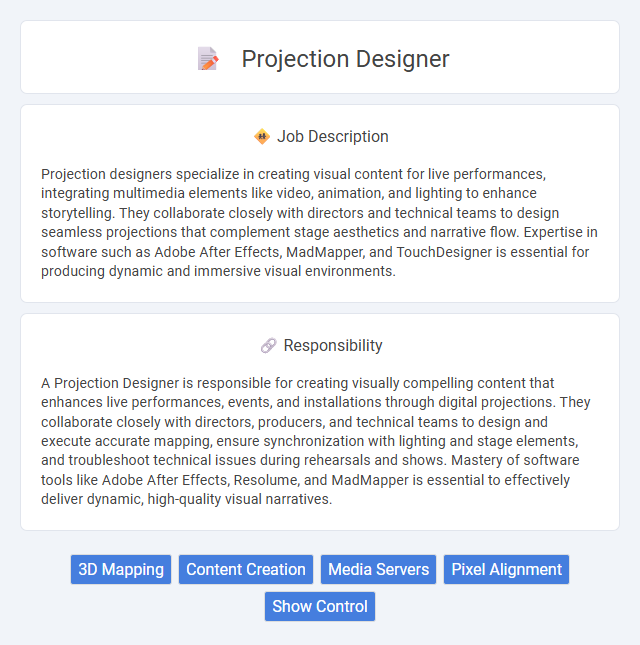
Projection designers specialize in creating visual content for live performances, integrating multimedia elements like video, animation, and lighting to enhance storytelling. They collaborate closely with directors and technical teams to design seamless projections that complement stage aesthetics and narrative flow. Expertise in software such as Adobe After Effects, MadMapper, and TouchDesigner is essential for producing dynamic and immersive visual environments.
Individuals with a strong interest in technology, creativity, and visual storytelling are likely to be well-suited for a projection designer role. Those who thrive in dynamic, collaborative environments and can manage high-pressure deadlines may find the job aligns with their skills and temperament. Conversely, people who prefer routine tasks or minimal screen time might struggle to adapt to the demands of this profession.
Qualification
Projection designers require proficiency in advanced software such as Adobe After Effects, MadMapper, and TouchDesigner for creating immersive visual experiences. Strong spatial awareness and a background in digital media, graphic design, or video production are essential for effectively mapping projections onto physical surfaces. Experience in live event production and collaboration with technical teams enhances their ability to deliver precise and impactful multimedia presentations.
Responsibility
A Projection Designer is responsible for creating visually compelling content that enhances live performances, events, and installations through digital projections. They collaborate closely with directors, producers, and technical teams to design and execute accurate mapping, ensure synchronization with lighting and stage elements, and troubleshoot technical issues during rehearsals and shows. Mastery of software tools like Adobe After Effects, Resolume, and MadMapper is essential to effectively deliver dynamic, high-quality visual narratives.
Benefit
A career as a projection designer likely offers unique creative opportunities to blend technology with visual storytelling, enhancing live performances and events. This role probably provides exposure to cutting-edge software and hardware, fostering skill development in digital design and multimedia integration. Employment as a projection designer might also grant collaborative experiences within artistic teams, potentially leading to diverse project work and professional networking.
Challenge
A projection designer's job likely involves navigating complex technical challenges to create seamless visual experiences that complement live performances. There is a high probability of encountering difficulties in synchronizing projections with lighting, sound, and stage movements while maintaining artistic integrity. Solving these problems often requires innovative thinking and adaptability to rapidly changing production demands.
Career Advancement
Projection designers specializing in creating immersive visual experiences for theater, concerts, and live events have growing career advancement opportunities as demand for innovative digital storytelling rises. Mastery of advanced software like TouchDesigner, MadMapper, and Adobe After Effects enhances employability and opens roles in creative direction and multimedia production management. Continuous skill development in augmented reality (AR) and virtual reality (VR) integration also positions projection designers for leadership roles in cutting-edge entertainment technology sectors.
Key Terms
3D Mapping
Projection designers specializing in 3D mapping create immersive visual experiences by projecting digital content onto complex surfaces like buildings, sculptures, and stage sets. They utilize advanced software tools such as MadMapper, Resolume, and TouchDesigner to align and synchronize video projections with architectural features, enhancing events, advertising, and performances. Expertise in spatial awareness, content creation, and real-time rendering is crucial to deliver precise and captivating projection mapping displays.
Content Creation
Projection designers specialize in creating dynamic digital content that integrates seamlessly with physical environments for live events, theater productions, and installations. Their expertise includes using advanced software like Adobe After Effects, Cinema 4D, and TouchDesigner to develop visually compelling animations, video mapping, and interactive visuals. By collaborating closely with directors and technical teams, projection designers enhance storytelling through precise content synchronization and innovative visual effects.
Media Servers
Projection designers specializing in media servers manage complex software like Disguise, Resolume, and Pandoras Box to create immersive visual experiences for events and installations. Their expertise includes mapping projections accurately onto various surfaces, synchronizing media playback, and optimizing server performance for seamless displays. Mastery of real-time rendering and knowledge of hardware integration ensure flawless execution in live environments.
Pixel Alignment
A projection designer specializing in pixel alignment ensures precise calibration of digital images onto physical surfaces, enhancing visual clarity and immersive experiences. Mastery in mapping software and hardware synchronization allows for flawless alignment of pixels, critical in large-scale projections and architectural mapping. Accurate pixel alignment minimizes distortion and maximizes the impact of projection design in live events, exhibitions, and installations.
Show Control
A Projection Designer specializing in Show Control integrates advanced multimedia technologies to synchronize video projections with lighting, sound, and stage automation systems, enhancing live event experiences. Expertise in software such as QLab, Watchout, or Disguise is essential for managing real-time media playback and triggering cues precisely during performances. Collaboration with technical directors and stage managers ensures seamless integration of projection elements within complex show control environments.
 kuljobs.com
kuljobs.com